
Winery Mas JaumeÉlevé en Fûts de Chêne Côtes du Roussillon Villages
In the mouth this red wine is a powerful with a nice balance between acidity and tannins.
This wine generally goes well with beef, veal or pasta.
The Élevé en Fûts de Chêne Côtes du Roussillon Villages of the Winery Mas Jaume is in the top 90 of wines of Côtes du Roussillon Villages.
Taste structure of the Élevé en Fûts de Chêne Côtes du Roussillon Villages from the Winery Mas Jaume
Light | Bold | |
Smooth | Tannic | |
Dry | Sweet | |
Soft | Acidic |
In the mouth the Élevé en Fûts de Chêne Côtes du Roussillon Villages of Winery Mas Jaume in the region of Languedoc-Roussillon is a powerful with a nice balance between acidity and tannins.
Food and wine pairings with Élevé en Fûts de Chêne Côtes du Roussillon Villages
Pairings that work perfectly with Élevé en Fûts de Chêne Côtes du Roussillon Villages
Original food and wine pairings with Élevé en Fûts de Chêne Côtes du Roussillon Villages
The Élevé en Fûts de Chêne Côtes du Roussillon Villages of Winery Mas Jaume matches generally quite well with dishes of beef, pasta or veal such as recipes of tournedos with foie gras, tagliatelle with spinach cream or tripe in the style of caen.
Details and technical informations about Winery Mas Jaume's Élevé en Fûts de Chêne Côtes du Roussillon Villages.
Discover the grape variety: Calabre blanc
This is a very old grape variety, most certainly of Italian origin, not to be confused with other grape varieties with the name or synonym Calabria. Writings sometimes mention a white calabre resulting from an intraspecific crossing between bicane and muscat à petits grains blancs, although we are not sure that it is the same variety described here. You will note below that the leaf is very similar to that of the muscat à petits grains, to be continued. It can still be found in Italy, Hungary, Romania, Czech Republic, Germany, Ukraine, ... in France it is almost unknown.
Informations about the Winery Mas Jaume
The Winery Mas Jaume is one of of the world's greatest estates. It offers 8 wines for sale in the of Côtes du Roussillon Villages to come and discover on site or to buy online.
The wine region of Côtes du Roussillon Villages
The wine region of Côtes du Roussillon Villages is located in the region of Côtes du Roussillon of Languedoc-Roussillon of France. Wineries and vineyards like the Domaine du Clos des Fées or the Domaine de Rombeau produce mainly wines red, white and pink. The most planted grape varieties in the region of Côtes du Roussillon Villages are Mourvèdre, Lledoner pelut and Pinot noir, they are then used in wines in blends or as a single variety. On the nose of Côtes du Roussillon Villages often reveals types of flavors of cherry, anise or black plum and sometimes also flavors of citrus fruit, tree fruit or fennel.
The wine region of Languedoc-Roussillon
Languedoc (formerly Coteaux du Languedoc) is a key appellation used in the Languedoc-Roussillon wine region of southern France. It covers Dry table wines of all three colors (red, white and rosé) from the entire region, but leaves Sweet and Sparkling wines to other more specialized appellations. About 75% of all Languedoc wines are red, with the remaining 25% split roughly down the middle between whites and rosés. The appellation covers most of the Languedoc region and almost a third of all the vineyards in France.
The word of the wine: Yeast
Micro-organisms at the base of all fermentative processes. A wide variety of yeasts live and thrive naturally in the vineyard, provided that treatments do not destroy them. Unfortunately, their replacement by laboratory-selected yeasts is often the order of the day and contributes to the standardization of the wine. Yeasts are indeed involved in the development of certain aromas.














